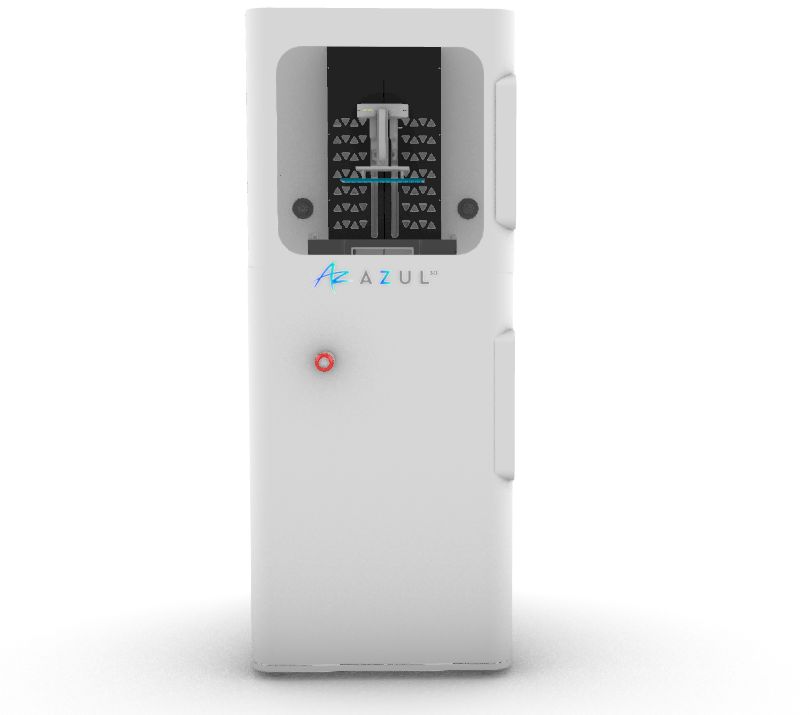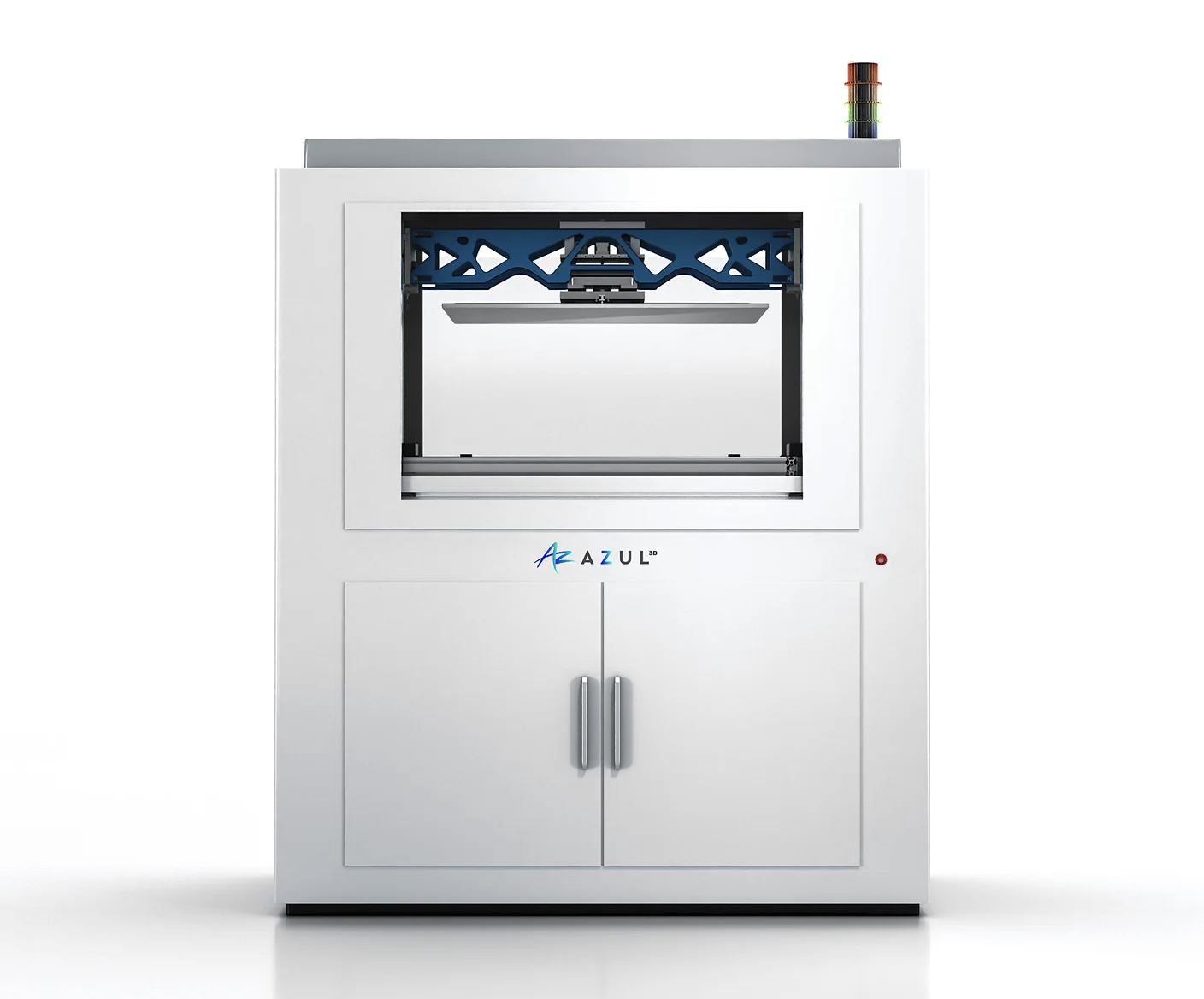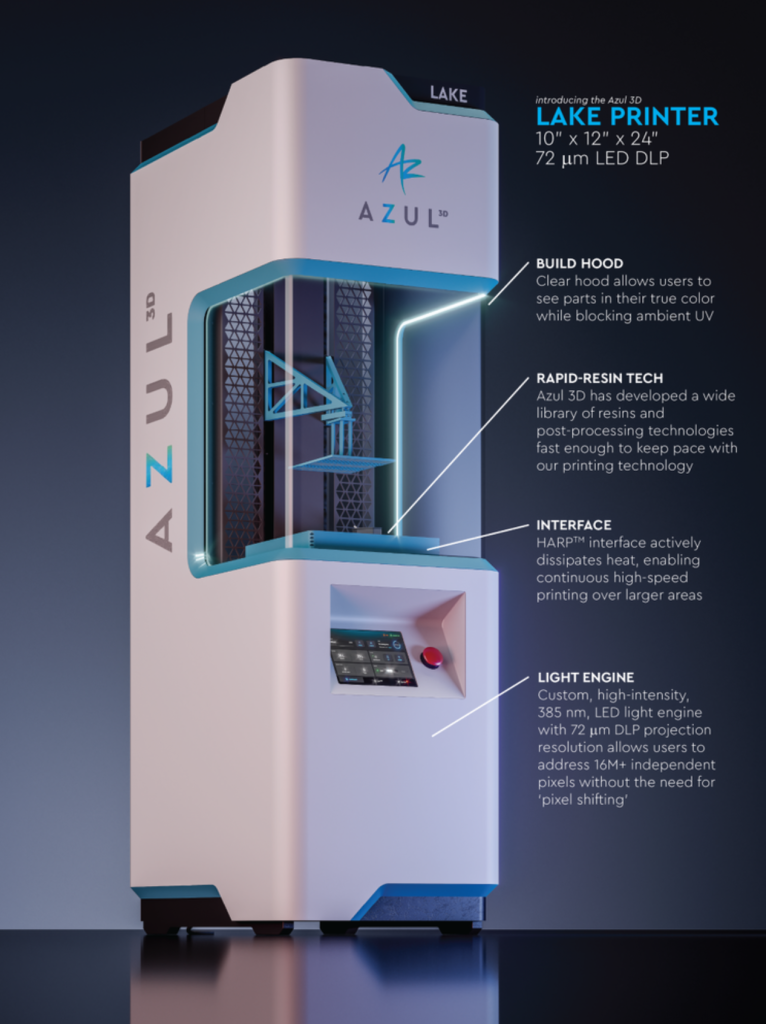Illinois-based 3D printer manufacturer Azul 3D has launched POND, a new small-scale DLP 3D printer designed to accelerate material and application development.
Based on the company’s proprietary High Area Rapid Printing (HARP) technology, POND boasts 72 µm 3D print resolution and features a high-intensity light projection system.
HARP is a modular technology that features what is said to be the “world’s only mobile liquid-liquid print interface” between the light source and the resin. This reportedly unlocks continuous 3D printing and full thermal control.
Significantly, the HARP process actively removes heat generated during resin 3D printing. A continuous flow of clear and non-reactive oil sits below the uncured resin. This maintains low temperature during long builds, enabling high throughput while controlling part dimensions and mechanical properties.
Azul 3D’s POND 3D printer is advertised as a research-friendly tool for the identification, validation, and commercialization of disruptive applications. According to Azul 3D, the processes and materials developed on the new 3D printer can be quickly scaled to more industrial production systems.

Azul 3D’s growing DLP 3D printer portfolio
POND is the latest addition to Azul 3D’s growing resin additive manufacturing portfolio, and follows the recent launch of its OCEAN 3D printer.
Optimized for industrial production and engineering applications, OCEAN is said to possess the “world’s largest and most productive area-wide 3D printing solution.” Featuring the proprietary HARP technology, it incorporates a substantial 812 x 812 mm build area.
As with POND, OCEAN’s DLP projection system enables 72 µm resolution for the production of parts with ultra-fine features. It also offers 3D print speeds of over 300 mm per hour.
A number of these systems have already been adopted by researchers developing novel manufacturing capabilities. Scientists at Sandia National Laboratory are leveraging the 3D printer’s liquid-liquid interface to embed electronics into 3D printed components. This could unlock new levels of integration and miniaturization in the consumer electronics industry.

Azul 3D introduced its first DLP 3D printer, called LAKE, back in 2021. Also harnessing HARP technology, this system can reportedly achieve 2000x the throughput of comparable industrial-grade resin 3D printers.
Possessing a 254 x 305 x 610 mm build volume, LAKE’s high-intensity LED light engine also enables 72 µm resolution. The light engine covers around 6 million individual pixels without the need for ‘pixel shifting.’ This technique is often used by other projectors to increase resolution by moving the pixels of the projected image between layers.

New DLP 3D printers hit the market
Azul 3D’s LAKE system is one of the newest additions to the DLP resin 3D printer market.
At Formnext 2023, 3D printer manufacturer Raise3D unveiled its DF2 solution, which featured the company’s first resin-based DLP 3D printer. The DF2 is advertised as combining rapid printing speeds, refined surfaces, and high precision, making it ideal for engineering prototyping and low-volume production.
The 3D printer offers 78.5 µm, 2560 x 1440 resolution resolution, and Anti-Aliasing technology to unlock highly detailed parts. Its light engine reportedly offers enhanced reliability and precise optical control. A stable 3D printing environment featuring curated LED sources, a dedicated DMD chip, and a low-distortion glass lens is also said to enhance performance.
More recently, Tethon 3D, a Nebraska-based ceramic 3D printing specialist, entered the DLP market with the Bison Bio DLP 3D printer. A desktop-sized system designed for R&D applications in the medical sector, the Bison Bio was developed with 3D printer manufacturer Carima.
The 385 nm vat polymerization 3D printer can be customized to incorporate three adjustable build sizes of 30 x 20 mm, 57 x 32 mm and 96 x 54 mm to meet a range of application needs. It reportedly offers superior cell viability to other bio-printers, ensuring a high percentage of live cells present within 3D printed scaffolds.
Want to help select the winners of the 2024 3D Printing Industry Awards? Join the Expert Committee today.
What does the future of 3D printing hold?
What near-term 3D printing trends have been highlighted by industry experts?
Subscribe to the 3D Printing Industry newsletter to keep up to date with the latest 3D printing news.
You can also follow us on Twitter, like our Facebook page, and subscribe to the 3D Printing Industry Youtube channel to access more exclusive content.
Featured image shows the new Azul 3D POND 3D printer. Image via Azul 3D.


